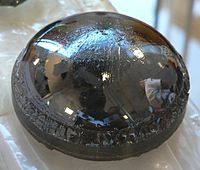
Photo from wikipedia
The porous ceramics with a skeleton structure of magnesium borate (Mg2B2O5) whiskers were in situ synthesized by firing a compact of high-energy ball milled mixtures containing the reactants of boric… Click to show full abstract
The porous ceramics with a skeleton structure of magnesium borate (Mg2B2O5) whiskers were in situ synthesized by firing a compact of high-energy ball milled mixtures containing the reactants of boric acid (H3BO3) and basic magnesium carbonate [(MgCO3)4 Mg(OH)2 5H2O] (BMC), and the transition metal oxides (Fe2O3 and NiO) sintering aids. The effect of sintering aids on the phase transformation, morphology development of Mg2B2O5 whiskers and physical properties of porous ceramics were investigated. The results demonstrated that the addition of Fe2O3 inhibited the phase transition from monoclinic Mg2B2O5 to triclinic Mg2B2O5 and promoted the increase of average aspect ratio of whiskers, while introduction of NiO retarded whisker growth. An optimal synthesis temperature for well-developed porous structure of all samples is at 850 °C. Compared with samples sintered without and with sintering aid NiO, sample sintered with Fe2O3 has higher average aspect ratio of whisker and open porosity as well as compressive strength at the same temperature.
Journal Title: Materials Research Express
Year Published: 2019
Link to full text (if available)
Share on Social Media: Sign Up to like & get
recommendations!